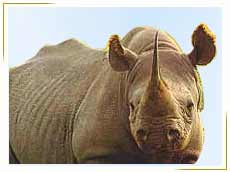 The Indian Rhinoceros, internationally known as the Great Indian One Horned Rhinoceros is a massively built beast of truly gigantic proportions that is next only to the Indian Elephant. A single One -Horned Rhino weighs about 1800 kg and is about 1.5 to 1.8 m tall. Though it could once be found throughout India in the grassy flood plains of the Indus, Ganga and Brahmaputra rivers, it is now restricted to the banks of the Brahmaputra, for its natural habitat of marshes, grassland and swamps has gradually been turned into farmland. The Indian Rhinoceros, internationally known as the Great Indian One Horned Rhinoceros is a massively built beast of truly gigantic proportions that is next only to the Indian Elephant. A single One -Horned Rhino weighs about 1800 kg and is about 1.5 to 1.8 m tall. Though it could once be found throughout India in the grassy flood plains of the Indus, Ganga and Brahmaputra rivers, it is now restricted to the banks of the Brahmaputra, for its natural habitat of marshes, grassland and swamps has gradually been turned into farmland.
The one-horned rhino is solitary in nature and spends hours wallowing in mud and water, or feeding on grasses. It usually confines its movements to within an area of 5 km sq, though the males may sometimes wander further in search of mates. One of their special features is the long noisy fights that occur between a male and a female at the time of courtship. Violent encounters ensue in a series of displays and postures involving curling of lips, and snorts and grunts. Rhinos can be amazingly agile despite their bulk and growth, and can charge at speeds of 4 to 8 km per hour.
The population of the one-horned rhino has decreased due to destruction of their natural habitat as well as unchecked and merciless poaching, for the mythical aphrodisiacal properties of its horn, as well as mythical medicinal properties of other parts of its body. One rhino horn can fetch as much as 20,000 US dollars, and even more in the international markets.
Indian Wildlife Authorities are now making a determined effort at rhino conservation. Translocation Projects are under operation, and the survival of the rhinos at all odds is the final goal. The Great Indian One Horned Rhinoceros can be found in the national reserves of Kaziranga, Manas and Jaldapara.
| 

